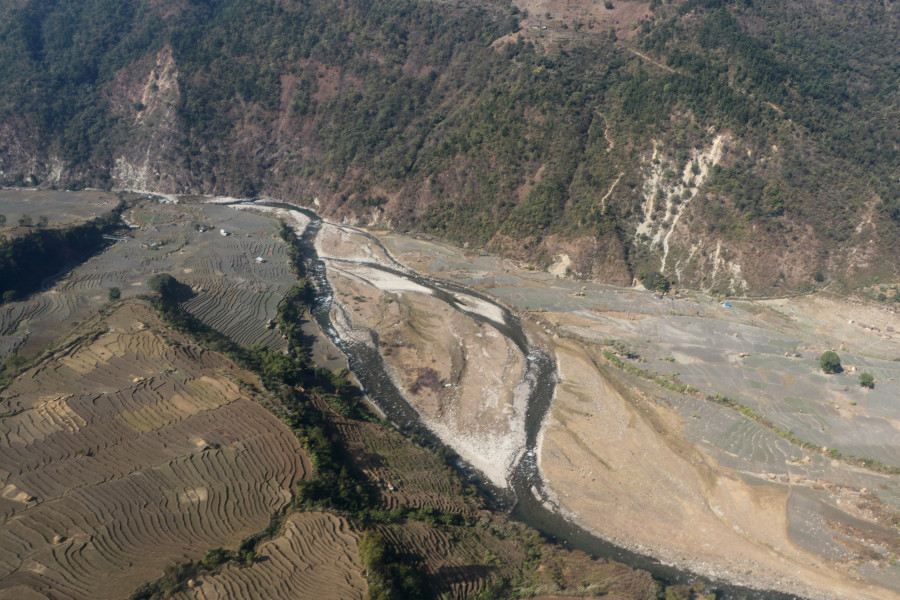Money
Construction of Dudh Koshi hydro project slated to begin this year
Officials are currently finalising the detailed design prepared by Japanese and Italian consultants.
Prahlad Rijal
Energy officials plan to begin construction of the Dudh Koshi Storage Hydroelectric Project this year by declaring it a national priority project and rushing the preliminary process.
Fed by the Dudh Koshi River which rushes down from the lower slopes of Everest foaming with snowmelt, the 635-megawatt scheme will not lack water to turn the turbines at full capacity even in the dry season. The river's churning whitewater has earned it the name 'river of milk'.
Speaking to local stakeholders in Rawabesi, Khotang on Tuesday, Energy Minister Barshaman Pun said that the ministry was planning to initiate the development process by declaring the storage scheme a priority project after a detailed final design is completed.
Officials are currently finalising the detailed design prepared by Japanese and Italian consultants. The approval of the final design will pave the way for the state-owned power utility to arrange finance and start building the plant located in Okhaldhunga and Khotang districts in eastern Nepal.
“The project will be built without adversely affecting local lives, and the residents who will be displaced will be resettled and paid a fair compensation,” said the minister.
The government has already paid out more than Rs26 billion in land compensation for the much-touted Budhi Gandaki reservoir scheme by levying a Rs5 infrastructure tax on every litre of gasoline, but the project is mired in politics and yet to get off the drawing board.
The Dudh Koshi reservoir type project will produce 3,443 GWh annually, more than the expected annual output of 3,383 GWh from the proposed Budhi Gandaki scheme.
As per a draft final design obtained by the Post, the total cost of the project has been estimated at $1.523 billion excluding taxes and other financial costs, and it will take six years to build the dam and other structures.
The report shows that the social impact of the Dudh Koshi scheme will be less as only 162 households will be severely impacted while 1,150 households will be partially affected.
“Its sound economic performance, as a possible storage hydropower project candidate, is dramatically strengthened by the negligible social impact, limited to a few tens of households,” the report said. “No potentially insurmountable impacts were identified which would necessitate a fundamental alteration of the proposed project design parameters.”
The announcement comes months after the energy minister met Chinese Ambassador to Nepal Hou Yanqi and sought the help of the northern neighbour to arrange funds for the Dudh Koshi scheme. During a meeting of the Nepal-Austria energy mechanism last October, Austrian officials had also expressed interest in assisting Nepal technically and financially to build the scheme.
According to Minister Pun, the Asian Developed Bank has come on board and pledged to invest Rs60 billion in the project. The government is holding consultations with potential domestic and international investors to manage the remaining funds.
An updated feasibility study for the Dudh Koshi Storage Hydroelectric Project recommends building a main underground powerhouse near the Sunkoshi River with four units generating 150 megawatts each and a small 35 megawatt hydro unit near the toe of the dam.
The dam will be located on the Dudh Koshi River in a gorge nearly 1 kilometre downstream of the confluence of the Dudh Koshi River and the Thotne Khola. The main dam will have a height of 220 metres and hold back 1,581 cubic megametres of water.
Japanese and Italian consultants have estimated the cost of the civil works at both powerhouses at $304.42 million. The estimated spending on the electromechanical works is $169.73 million. Environmental and social impact mitigation would cost the project $104.39 million.
The scheme will also build a $58.31 million high capacity transmission line and two substations which will relay power to the interconnection point at Dhalkebar substation. A 22.3-kilometre double circuit 400 kV line will run from the Sun Koshi River to the Dudh Koshi switchyard, and a 90.9-kilometre line will relay power from Dudh Koshi to Dhalkebar.
The project will also build three access roads running through the Mid-Hill Highway and Dudh Koshi Valley, and restore connectivity of three routes in the Thotne Khola and Rawa Khola area.
As per the feasibility study, there will also be non-energy benefits like irrigation, increased agricultural yields, improved flood control and tourism development.




 8.12°C Kathmandu
8.12°C Kathmandu















